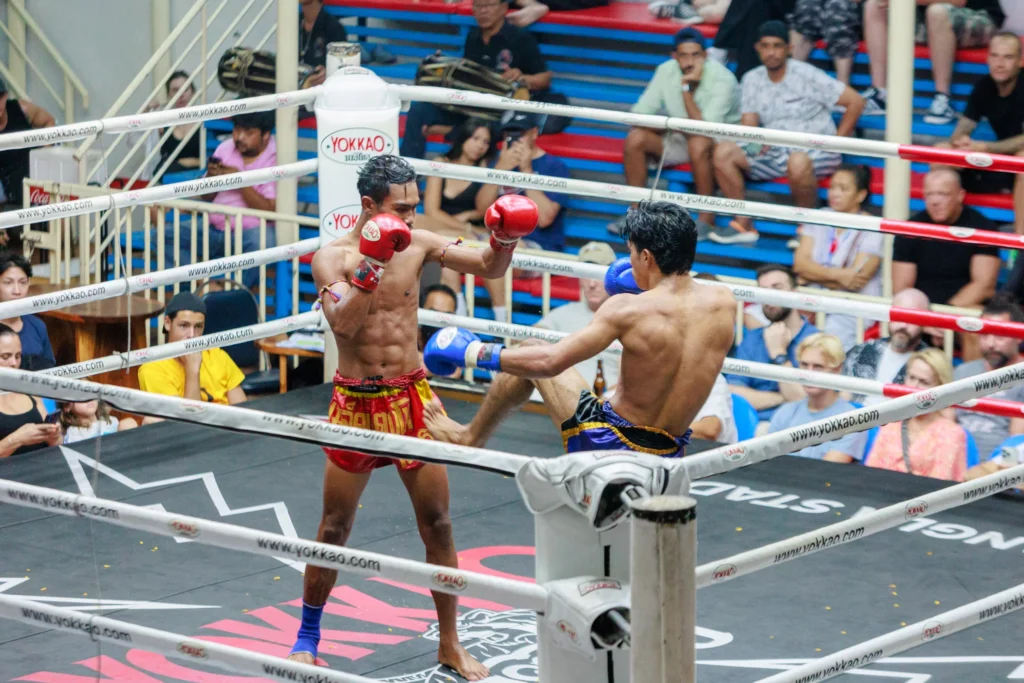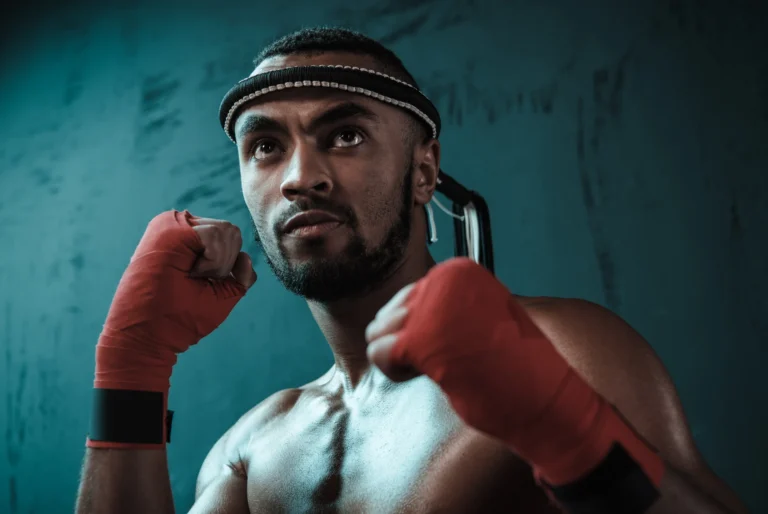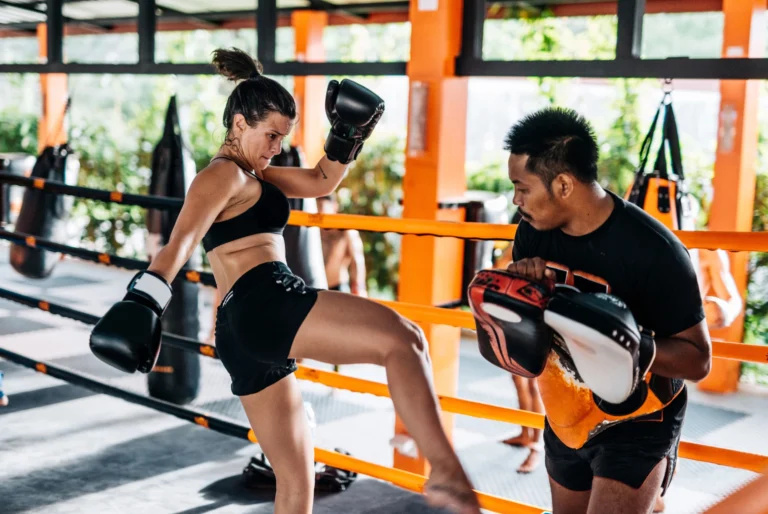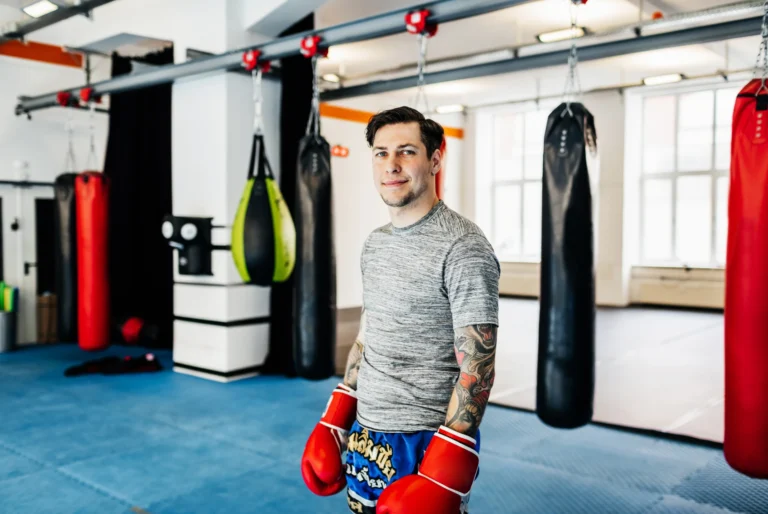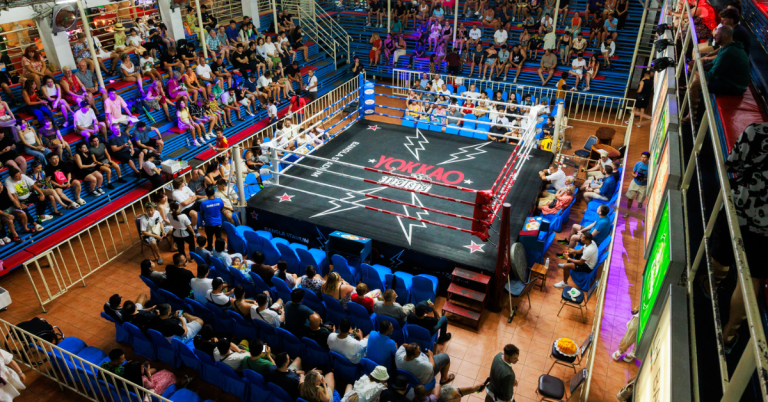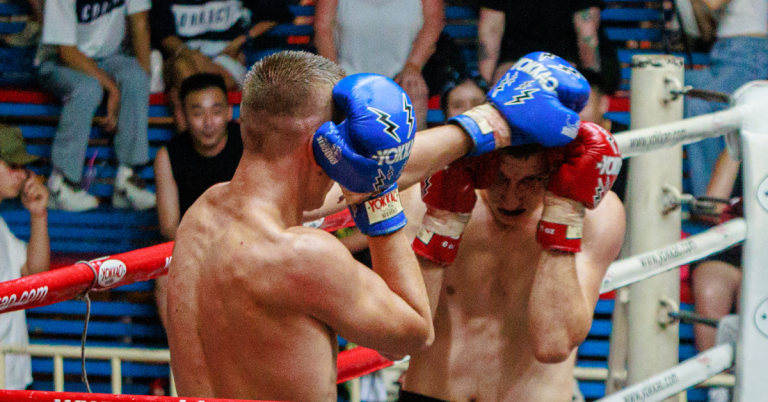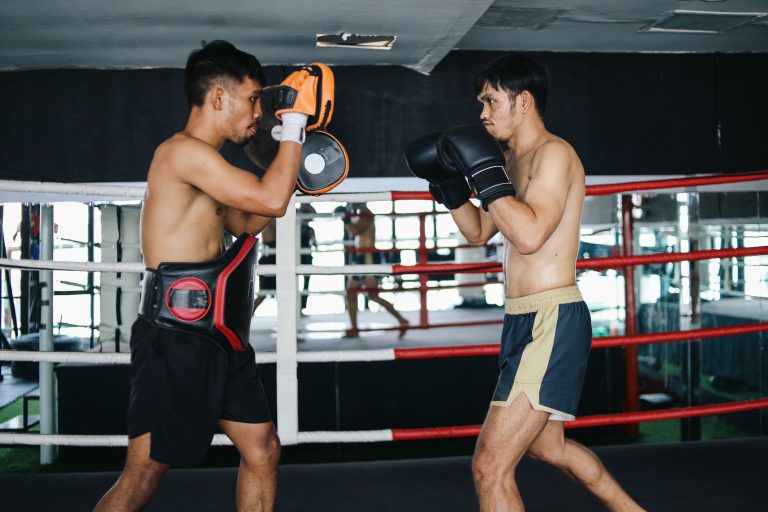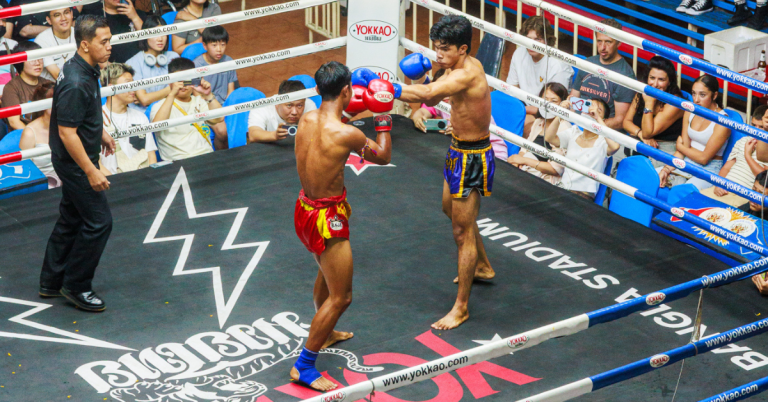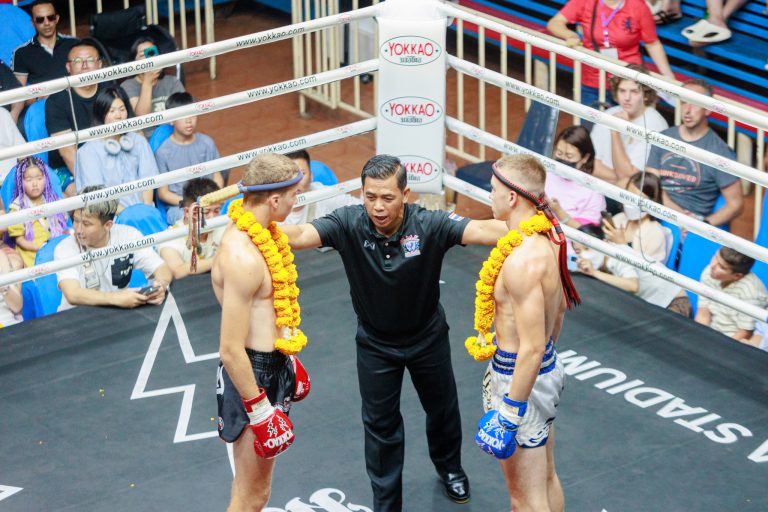Muay Thai distinguishes itself from conventional combat sports through its comprehensive striking system utilizing eight points of contact, earning the distinguished designation “Art of Eight Limbs.” This sophisticated martial art enables fighters to deploy fists, elbows, knees, and shins as integrated weapons, creating tactical complexity unmatched in traditional boxing or most other striking disciplines.
Thailand’s national sport represents far more than physical combat methodology – it embodies centuries of martial tradition, cultural identity, and warrior philosophy refined through generations of dedicated practitioners. Modern Muay Thai preserves ancient techniques while adapting to contemporary competitive standards observable during professional fights at venues like Bangla Boxing Stadium and Patong Boxing Stadium.
Understanding the eight-limb system enhances appreciation for professional competition where skilled fighters demonstrate tactical versatility impossible in limited-weapon combat sports. Each weapon serves specific strategic purposes, from long-range teep kicks establishing distance to devastating close-range elbow strikes capable of ending fights instantaneously. Witnessing these techniques executed by professional Thai boxers during live stadium events reveals mastery levels developed through years of rigorous traditional training.
Historical Development of Eight-Limb Fighting
Ancient Siamese military combat systems evolved into modern Muay Thai through centuries of battlefield refinement and peacetime systematization. Historical records document Thai warriors utilizing comprehensive striking arsenals incorporating all body weapons during conflicts with neighboring kingdoms, with techniques passed generationally through military and royal guard training programs.
Battlefield Origins and Military Applications
Traditional Siamese warfare emphasized versatile hand-to-hand combat skills enabling soldiers to fight effectively when disarmed or engaging in close-quarters combat. The eight-limb approach developed pragmatically as warriors discovered advantages of deploying multiple striking tools adapted to varied combat ranges and tactical situations encountered during actual warfare.
Elbow and knee techniques proved particularly valuable in armored combat where traditional punches lacked stopping power against protected opponents. Shin conditioning enabled powerful kicks capable of incapacitating enemies even through padding or light armor. This practical battlefield effectiveness ensured technique preservation and continual refinement throughout Thailand’s martial history.
Peacetime Evolution and Sporting Adaptation
As Thailand experienced extended peace periods, martial techniques transitioned from pure combat applications to ceremonial demonstrations and competitive sporting contexts. Village festivals featured Muay Thai competitions celebrating martial prowess while maintaining warrior traditions during peacetime generations. These events evolved into formal competitive structures with established rules, weight classes, and judging criteria.
The integration of boxing ring formats, gloves, and round-based timing during the early 20th century standardized Muay Thai competition while preserving traditional eight-limb technique applications. Modern rules balance fighter safety with authentic technique demonstration, enabling professional competition showcasing ancient martial arts within contemporary sporting frameworks observable at Phuket’s professional stadiums.
Cultural Preservation Through Generations
Master-student lineages maintained technical knowledge and philosophical teachings across centuries, creating unbroken martial traditions connecting modern fighters to ancient warrior heritage. Traditional training camps (gyms) serve as cultural preservation centers where experienced trainers (kru) transmit refined techniques alongside ethical teachings emphasizing respect, discipline, and personal development.
This generational knowledge transfer ensures authentic Muay Thai preservation despite modernization and international popularization. Professional fighters training for competitions at Bangla Boxing Stadium follow methodologies refined over centuries, maintaining technical authenticity while achieving contemporary competitive excellence.
The Eight Weapons: Complete Strike Arsenal
Muay Thai’s designation as eight-limb art references four weapon pairs enabling comprehensive striking capabilities across all combat ranges. Understanding each weapon’s technical applications and strategic purposes illuminates the tactical sophistication distinguishing expert practitioners from novice fighters.
Fists: Foundation Striking Techniques
Boxing-style punching forms Muay Thai’s foundational striking base, providing rapid-fire attacks, combination setups, and defensive applications. Fighters employ jabs establishing range and rhythm, crosses delivering power strikes, hooks attacking from angles, and uppercuts exploiting guard openings.
Primary Fist Techniques:
- Jab (Mat Trong): Range-finding strike establishing distance control and disrupting opponent rhythm
- Cross (Mat Kwaa): Power punch generating force through hip rotation and weight transfer
- Hook (Mat Wiang San): Curved strike attacking from outside opponent’s vision line
- Uppercut (Mat Soei): Rising punch targeting opponent’s chin through guard openings
Effective punching requires proper technique emphasizing full-body power generation rather than arm strength alone. Professional fighters observable during stadium competitions demonstrate seamless punch integration within comprehensive eight-limb attack sequences, using fists to set up kicks, knees, and elbows while maintaining defensive positioning.
Elbows: Close-Range Devastation
Elbow strikes represent Muay Thai’s most dangerous close-range weapons, capable of generating knockout force over minimal distances while causing severe cutting damage. The elbow’s hard bone structure and sharp point create impact concentrations exceeding fist or shin strikes, making elbow techniques feared components of professional fighting arsenals.
Primary Elbow Techniques:
- Horizontal Elbow (Sok Tad): Sideways strike targeting opponent’s temple or jaw
- Uppercut Elbow (Sok Ngad): Rising elbow attacking chin or solar plexus
- Downward Elbow (Sok Toh): Descending strike targeting crown or collarbone
- Spinning Elbow (Sok Klap): Rotating technique generating massive rotational force
- Forward Elbow (Sok Pung): Thrusting strike driving elbow point into opponent
Professional fighters at Patong Boxing Stadium regularly demonstrate elbow mastery during clinch exchanges, delivering precision strikes that create dramatic fight conclusions through technical knockouts or cuts requiring bout stoppages. Elbow technique mastery requires years of dedicated practice developing targeting accuracy, timing precision, and power generation mechanics.
Knees: Dominant Clinch Weapons
Knee strikes provide devastating power during clinch exchanges where fighters grapple at close range controlling opponent positioning through neck and body grips. Effective knee technique combines powerful hip drive with precise targeting, enabling strikes to body, ribs, and head that can break opponent resistance or end fights through accumulated damage.
Primary Knee Techniques:
- Straight Knee (Kao Trong): Direct thrust targeting opponent’s midsection or solar plexus
- Diagonal Knee (Kao Chiang): Angled strike attacking ribs or liver
- Curving Knee (Kao Khong): Hooking technique targeting side body or kidneys
- Small Knee (Kao Noi): Rapid short-range knees during tight clinch control
- Flying Knee (Kao Loi): Leaping strike covering distance for dramatic head attacks
Clinch fighting represents distinctly Thai martial arts application rarely seen in Western boxing or kickboxing. Professional fighters demonstrate sophisticated clinch tactics during live stadium competitions, controlling opponent positioning while delivering powerful knee combinations that judges heavily weight when scoring rounds.
Shins: Foundational Kicking Arsenal
Shin-based kicking differentiates Muay Thai from martial arts using instep or foot striking. Conditioning transforms shins into powerful weapons capable of delivering bone-crushing kicks without injury to attacking fighters. The shin’s length and hardness enable powerful strikes while providing defensive blocking capabilities.
Primary Shin-Based Kicks:
- Roundhouse Kick (Tae Tad): Signature technique generating power through full hip rotation
- Push Kick/Teep (Tae Teep): Defensive technique establishing distance or disrupting opponent rhythm
- Low Kick (Tae Lam Tuua): Leg attacks targeting opponent’s thigh muscles
- High Kick (Tae Soke): Head-targeting technique requiring exceptional flexibility
- Switch Kick (Tae Chiang): Deceptive technique changing stance mid-kick
Shin conditioning through repeated bag work and pad training creates bone density increases enabling powerful kicking without fracture risk. Watching professional fighters execute perfect roundhouse kicks during stadium events reveals years of conditioning and technical refinement necessary for mastery-level performance.
Tactical Integration: Combining Eight Weapons
True Muay Thai mastery lies not in individual technique proficiency but in seamless weapon integration creating unpredictable attack sequences that opponents struggle to defend. Expert fighters flow naturally between ranges, adapting weapon selection to distance, opportunity, and strategic objectives while maintaining defensive awareness.
Range Management and Weapon Selection
Different weapons optimize for specific fighting ranges, requiring fighters to understand distance relationships and position themselves advantageously:
Long Range (Kicking Distance):
- Primary weapons: Teep (push kick), roundhouse kicks
- Strategic purpose: Establishing distance control, point scoring
- Defensive considerations: Maintaining balance, preventing clinch entries
Mid Range (Punching Distance):
- Primary weapons: Punches, high kicks
- Strategic purpose: Combination striking, transitional positioning
- Defensive considerations: Head movement, guard maintenance
Close Range (Clinch Distance):
- Primary weapons: Elbows, knees
- Strategic purpose: Damage accumulation, position control
- Defensive considerations: Grip fighting, balance maintenance
Professional fighters observable during Bangla Boxing Stadium events demonstrate masterful range management, using kicks to control distance, punches to create entries, and devastating close-range weapons when opportunities present themselves.
Combination Striking Sequences
Effective combination striking requires understanding how individual techniques set up subsequent attacks through opponent reactions and defensive adjustments:
Classic Combinations:
- Jab → Cross → Low Kick: Basic combination utilizing different ranges
- Lead Hook → Rear Elbow: Close-range devastation sequence
- Push Kick → Roundhouse Kick: Rhythm disruption creating opening
- Punch Combination → Clinch Entry → Knee Strikes: Range transition sequence
Advanced fighters develop personal combination preferences matching their physical attributes, stylistic strengths, and opponent vulnerabilities. This tactical creativity makes professional Muay Thai competition endlessly variable despite standardized technique foundations.
Defensive Applications of Eight Limbs
The eight-limb system provides comprehensive defensive capabilities alongside offensive applications:
Defensive Techniques:
- Shin Blocks: Using shins to intercept opponent kicks, minimizing damage
- Elbow Blocks: Protecting head through raised elbow positioning
- Teep Defense: Using push kicks to maintain distance and prevent aggression
- Catch and Counter: Grabbing opponent kicks for takedown or counter-strike opportunities
Defensive mastery distinguishes champion-level fighters from journeyman competitors. Skilled practitioners observable during professional stadium fights block, evade, and counter opponent attacks seamlessly while maintaining offensive threat presence.
Cultural Significance and Traditional Elements
Muay Thai transcends pure sporting competition, embodying profound cultural significance connecting modern practitioners to centuries of Thai warrior heritage. Traditional ceremonies, spiritual elements, and ethical teachings distinguish authentic Thai boxing from mere fighting technique collections.
Wai Kru Ram Muay: Pre-Fight Ritual
The Wai Kru Ram Muay ceremony performed before every traditional Muay Thai fight honors teachers, parents, and spiritual protectors while allowing fighters mental preparation and ring familiarization. These intricate dance-like movements demonstrate respect for martial traditions while showcasing individual fighter style and personality.
Each fighter’s Ram Muay sequence reflects personal training lineage, regional styles, and individual creative expression. Music played by live traditional ensembles (piphat) accompanies ceremonies, creating distinctive atmospheric elements observable at authentic venues like Patong Boxing Stadium where cultural authenticity remains prioritized.
The Mongkol (sacred headband) worn during ceremonies contains blessed elements providing spiritual protection. Fighters remove Mongkol after ceremonies, signifying readiness for combat while maintaining spiritual connection to training traditions and protective forces.
Sarama Music: Traditional Fight Accompaniment
Live traditional music played throughout Muay Thai competitions serves multiple purposes beyond atmospheric enhancement. The tempo increases as fights intensify, creating rhythmic accompaniment matching action escalation. Musicians (piphat ensemble) include:
- Pi Java: Reed instrument providing melodic lead
- Glong Khaek: Double-headed drums maintaining rhythm
- Ching: Small cymbals marking timing
- Klong That: Large drums emphasizing dramatic moments
Fighters often synchronize movement and breathing to musical rhythms, using traditional sounds for timing and pacing. This musical integration creates unique atmospheric experiences distinguishing authentic Muay Thai from international kickboxing competitions lacking cultural elements.
Mongkol and Prajioud: Sacred Elements
Traditional fighters wear consecrated items providing spiritual protection and luck during competition:
Mongkol (Sacred Headband):
- Blessed by Buddhist monks or respected trainers
- Contains sacred texts, talismans, or protective elements
- Worn only during Wai Kru, removed before fighting
- Represents connection to training lineage and spiritual traditions
Prajioud (Armbands):
- Worn on upper arms throughout fights
- Often contain blessed cloth or protective amulets
- Represent gym affiliation and trainer blessing
- Provide psychological confidence through spiritual connection
These sacred elements reflect Muay Thai’s spiritual dimensions transcending pure physical competition, observable during traditional ceremonies preceding fights at Phuket’s authentic stadium venues.
Modern Muay Thai: Global Sport with Thai Soul
Contemporary Muay Thai balances international sporting popularization with cultural authenticity preservation, creating global martial arts phenomenon while maintaining essential Thai character and traditional values.
International Expansion and Adaptation
Muay Thai’s effectiveness as striking system combined with cultural intrigue drove international adoption throughout the 20th century. Western practitioners initially encountered Thai boxing through military exchanges and Southeast Asian travel, spreading techniques through martial arts schools globally.
Modern international Muay Thai maintains technical foundations while adapting to varied cultural contexts and sporting regulations. Organizations worldwide promote Muay Thai competition while respecting traditional Thai elements including ceremonial components and classical technique applications.
Professional Stadium Competition in Thailand
Despite international growth, Thailand remains Muay Thai’s spiritual and competitive center. Bangkok’s legendary Lumpinee and Rajadamnern stadiums alongside regional venues including Phuket’s Bangla and Patong Boxing Stadiums maintain highest competitive standards while preserving cultural authenticity.
Professional Thai fighters train from childhood in traditional camps, developing skills through proven methodologies passed generationally. Stadium competition in Thailand represents pinnacle achievement for serious practitioners worldwide, offering authentic cultural immersion alongside elite-level technical displays.
Training Methodology and Fighter Development
Traditional Muay Thai training emphasizes:
Physical Conditioning:
- Extensive bag work developing power and conditioning
- Pad work with trainers refining technique and combinations
- Sparring developing timing, distance, and tactical awareness
- Running and conditioning building cardiovascular endurance
Technical Development:
- Progressive skill building from fundamental to advanced techniques
- Personalized instruction matching individual attributes and styles
- Cultural education including ceremony performance and etiquette
- Mental preparation developing warrior mindset and competitive psychology
Lifestyle Integration:
- Disciplined daily schedules emphasizing training dedication
- Nutritional awareness for weight management and performance optimization
- Rest and recovery protocols preventing overtraining
- Ethical teachings promoting respect, humility, and personal development
Witnessing Eight-Limb Mastery: Live Stadium Experiences
Understanding Muay Thai’s technical sophistication and cultural significance transforms through live professional fight attendance where theoretical knowledge becomes observable reality. Stadium events showcase eight-limb system applications by skilled Thai fighters demonstrating years of traditional training refinement.
Optimal Viewing for Technique Observation
Ringside seating positions spectators ideally for appreciating strike impact, defensive subtleties, and tactical adjustments that define professional-level competition. Proximity enables:
- Strike Impact Recognition: Hearing and seeing powerful kicks, elbows, and knees landing
- Defensive Technique Appreciation: Observing blocks, evasions, and counter-timing
- Clinch Work Details: Understanding grip fighting and positional dominance
- Fighter Conditioning: Recognizing stamina, power, and technical endurance
Premium ringside tickets at Bangla (1,900 THB) and Patong stadiums (1,800 THB) provide optimal educational viewing experiences. Direct booking through official channels offers 5% discounts (90-95 THB savings) while guaranteeing authentic tickets and preferred seating allocation.
Eight-Limb Applications Across Fight Card
Professional stadium events feature eight matches showcasing varied fighter styles, experience levels, and tactical approaches. This diversity illustrates eight-limb system’s tactical flexibility:
Opening Bouts: Developing fighters demonstrate foundational techniques with occasional breakthrough moments showcasing natural talent emerging through training.
Mid-Card Fights: Experienced competitors display refined techniques and tactical sophistication, mixing all eight weapons seamlessly while demonstrating advanced clinch work and combination striking.
Main Events: Elite fighters showcase mastery-level performance where decades of training culminate in technical excellence, tactical intelligence, and warrior spirit that defines Thai boxing’s highest expressions.
Cultural Ceremony Integration
Traditional Wai Kru performances preceding fights provide cultural context illuminating Muay Thai’s spiritual dimensions beyond pure sport. Observing ceremonies live reveals:
- Individual fighter personality through unique Ram Muay sequences
- Regional style variations reflecting Thailand’s diverse martial traditions
- Respect for teachers and training lineages through precise ritual observance
- Spiritual preparation combining physical readiness with mental focus
Live Sarama music creates atmospheric distinctiveness impossible to replicate through video viewing, with rhythmic intensity matching fight action escalation throughout events.
Educational Value for Martial Arts Practitioners
Serious martial artists particularly benefit from live professional Muay Thai observation:
- Technique Study: Observing proper execution of strikes, blocks, and combinations
- Tactical Analysis: Understanding distance management, timing, and strategic adaptation
- Conditioning Insights: Recognizing physical demands and stamina requirements
- Cultural Understanding: Appreciating martial arts’ ethical and spiritual dimensions
Many international visitors attending Phuket stadium events cite live fight experiences as pivotal in their martial arts development, providing technique insights and motivational inspiration impossible through instruction alone.
Frequently Asked Questions
What distinguishes Muay Thai’s “eight limbs” from other martial arts?
Muay Thai permits fists, elbows, knees, and shins as striking weapons (eight contact points total), contrasting with boxing’s fist-only approach or traditional karate’s limited kicking and punching. This comprehensive weapon arsenal enables tactics across all fighting ranges from long-distance kicks through close-range elbow and knee exchanges. The integration of clinch fighting with devastating knee strikes particularly distinguishes Thai boxing from kickboxing styles lacking grappling elements.
How long does mastering eight-limb techniques require?
Fundamental proficiency develops within 1-2 years of consistent training though mastery requires decades of dedicated practice. Professional Thai fighters often begin training during childhood (ages 6-8), accumulating 10-15 years experience before reaching elite competition levels. Amateur practitioners achieve satisfactory technical competency within 3-5 years though continual refinement characterizes serious martial artists throughout training careers. Observing professional fighters at Bangla Boxing Stadium reveals technical sophistication distinguishing experienced practitioners from developing fighters.
Which eight-limb weapon proves most effective in competition?
No single weapon dominates as effectiveness depends on fighter attributes, tactical situations, and opponent vulnerabilities. Kicks score frequently due to striking range and power generation. Elbows cause dramatic fight conclusions through cuts or knockouts. Knees dominate clinch exchanges. Effective fighters master all weapons while developing personal preferences matching physical strengths and stylistic approaches. Professional competition observable during stadium events showcases diverse tactical approaches emphasizing different weapon combinations.
Can visitors without martial arts experience appreciate professional Muay Thai?
Absolutely. While technical knowledge enhances appreciation, the athletic spectacle, cultural ceremonies, and competitive drama appeal universally. Stadium atmospheres combining traditional music, ceremonial elements, and enthusiastic crowds create engaging experiences regardless of martial arts background. Basic understanding of eight-limb concept and scoring criteria (available through pre-fight briefings at venues like Patong Boxing Stadium) sufficiently orients newcomers for enjoyable viewing experiences.
How does shin conditioning work without permanent injury?
Systematic progressive training gradually increases shin bone density through controlled micro-trauma and healing cycles. Fighters begin with light bag work, progressively increasing impact force over months and years. Proper technique emphasizing rotation and follow-through distributes forces appropriately while avoiding fragile areas like shins’ front edges. Adequate rest between training sessions permits bone remodeling strengthening targeted areas. Modern understanding of conditioning science enables safe shin development without compromising long-term health when proper methodologies followed.
What makes Thailand’s stadium Muay Thai more authentic than international venues?
Thai stadium competitions maintain complete traditional elements including live Sarama music, mandatory Wai Kru ceremonies, and cultural protocols absent from some international promotions prioritizing Western sporting conventions. Professional fighters in Thailand typically train within traditional camp systems emphasizing cultural education alongside technical development. Judging criteria in Thai stadiums often reflect traditional scoring values emphasizing technique quality and later-round performance. The atmospheric combination of ceremonial elements, musical accompaniment, and knowledgeable local audiences creates distinctly Thai experiences.
Where can eight-limb technique mastery be observed in professional competition?
Bangla Boxing Stadium (Tuesday, Wednesday, Friday, Sunday) and Patong Boxing Stadium (Monday, Thursday, Saturday) host professional Muay Thai featuring skilled Thai fighters demonstrating authentic eight-limb applications. Direct booking through official channels provides 5% discounts on all seating categories while guaranteeing authentic tickets and priority allocation. Eight nightly professional bouts showcase varied styles and experience levels illustrating eight-limb system’s tactical versatility.
Conclusion: Eight Limbs as Living Tradition
The “Art of Eight Limbs” represents far more than fighting technique classification – it embodies centuries of Thai martial tradition, cultural identity, and warrior philosophy preserved through generational transmission. Modern Muay Thai maintains technical authenticity while adapting to contemporary competitive frameworks, creating global sporting phenomenon without sacrificing essential cultural character.
Understanding eight-limb system principles enhances appreciation for professional competition observable at Phuket’s premier venues where skilled fighters demonstrate tactical sophistication developed through years of traditional training. Each weapon serves specific strategic purposes while integrated combinations showcase mastery distinguishing elite practitioners from developing fighters.
Live stadium experiences transform theoretical knowledge into visceral understanding as professional Thai boxers demonstrate eight-limb mastery combining power, precision, and tactical intelligence refined through rigorous traditional methodologies. Ringside positioning at Bangla and Patong Boxing Stadiums enables optimal technique observation while traditional ceremonies provide cultural context illuminating spiritual dimensions transcending pure physical competition.
Direct ticket booking through official channels ensures authentic experiences while providing 5% discount savings and priority seating allocation. Advance reservations secure preferred fight dates while eliminating availability concerns during peak tourism seasons when stadium demand intensifies.
Witness authentic Thai boxing mastery showcasing centuries of martial tradition through modern professional competition celebrating Thailand’s national sport and warrior heritage.
Related Reading:
